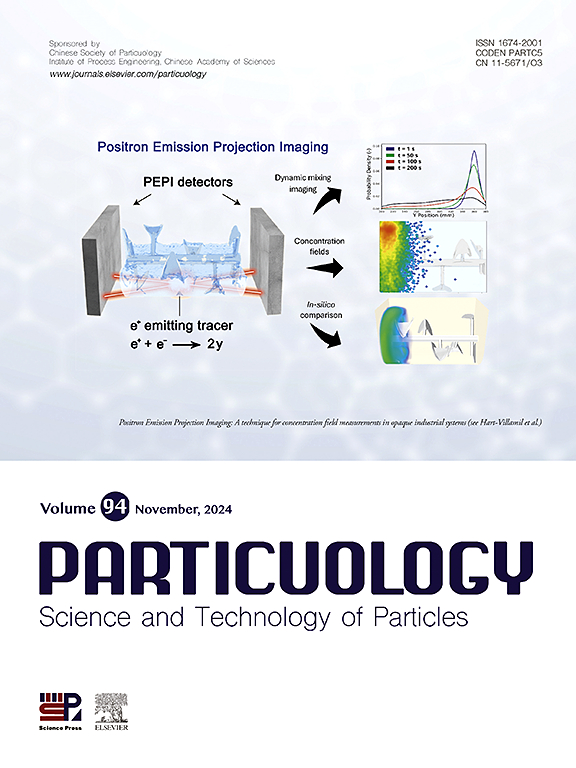Enhanced solar absorption and steam generation in lithium bromide-based modified copper oxide nanofluids under simulated solar flux
IF 4.1
2区 材料科学
Q2 ENGINEERING, CHEMICAL
引用次数: 0
Abstract
Multiphase flow and heat transfer processes are involved in various applications, such as water desalination, sterilisation, and power generation. Environmentally friendly and sustainable system operation can be ensured through the utilisation of renewable energy resources. Furthermore, the thermal efficiency of these systems can be enhanced by using nanofluids. This study reports an experimental investigation of the photothermal conversion properties of polyethylenimine (PEI) functionalised Copper oxide (CuO) nano particles used in Lithium Bromide (LiBr) salt solutions. The nano particles were characterised by the dynamic light scattering (DLS), transmission electron microscope (TEM), ultraviolet visible (UV–Vis) spectrophotometer. The long-term stability of the prepared nanofluid was evaluated using a high-speed centrifuge analyser. The instability index of 0.071 ± 0.002 indicated low agglomeration and sedimentation tendencies. Photothermal conversion efficiency for different concentrations of CuO was experimentally investigated under a solar simulator. The experiments were conducted with nanofluids containing 55 wt% of LiBr and PEI functionalised nanoparticles, with loading ranging from 0.05 to 0.15 wt%. The addition of nanoparticles resulted in an increase in surface temperature, up to 90.69 ± 2.7 % higher than the base case tested with deionised water (DIW). Experimental results further confirms that the nanofluid tested in this study has the potential to significantly increase solar energy trapping efficiency and evaporation rate due to a localised solar energy harvesting by the surface of nanofluid. It was found that a 0.1 wt% CuO NP concentration is the optimum nanofluid concentration in terms of stability for enhanced sensible and latent heat efficiencies.

模拟太阳通量下溴化锂基改性氧化铜纳米流体的增强太阳吸收和蒸汽生成
多相流和传热过程涉及多种应用,如海水淡化、消毒和发电。通过利用可再生能源,可以确保系统运行的环保性和可持续性。此外,使用纳米流体还能提高这些系统的热效率。本研究报告对溴化锂(LiBr)盐溶液中使用的聚乙烯亚胺(PEI)功能化氧化铜(CuO)纳米粒子的光热转换特性进行了实验研究。纳米颗粒的表征方法包括动态光散射(DLS)、透射电子显微镜(TEM)和紫外可见分光光度计(UV-Vis)。使用高速离心分析仪对制备的纳米流体的长期稳定性进行了评估。不稳定指数为 0.071 ± 0.002,表明团聚和沉淀倾向较低。在太阳能模拟器下对不同浓度 CuO 的光热转换效率进行了实验研究。实验使用的纳米流体含有 55 wt% 的 LiBr 和 PEI 功能化纳米粒子,负载量为 0.05 至 0.15 wt%。添加纳米粒子后,表面温度升高,与使用去离子水(DIW)测试的基本情况相比,最高升高了 90.69 ± 2.7%。实验结果进一步证实,本研究中测试的纳米流体具有显著提高太阳能捕获效率和蒸发率的潜力,这是由于纳米流体表面局部收集了太阳能。研究发现,就提高显热和潜热效率的稳定性而言,0.1 wt% 的 CuO NP 浓度是最佳的纳米流体浓度。
本文章由计算机程序翻译,如有差异,请以英文原文为准。
求助全文
约1分钟内获得全文
求助全文
来源期刊

Particuology
工程技术-材料科学:综合
CiteScore
6.70
自引率
2.90%
发文量
1730
审稿时长
32 days
期刊介绍:
The word ‘particuology’ was coined to parallel the discipline for the science and technology of particles.
Particuology is an interdisciplinary journal that publishes frontier research articles and critical reviews on the discovery, formulation and engineering of particulate materials, processes and systems. It especially welcomes contributions utilising advanced theoretical, modelling and measurement methods to enable the discovery and creation of new particulate materials, and the manufacturing of functional particulate-based products, such as sensors.
Papers are handled by Thematic Editors who oversee contributions from specific subject fields. These fields are classified into: Particle Synthesis and Modification; Particle Characterization and Measurement; Granular Systems and Bulk Solids Technology; Fluidization and Particle-Fluid Systems; Aerosols; and Applications of Particle Technology.
Key topics concerning the creation and processing of particulates include:
-Modelling and simulation of particle formation, collective behaviour of particles and systems for particle production over a broad spectrum of length scales
-Mining of experimental data for particle synthesis and surface properties to facilitate the creation of new materials and processes
-Particle design and preparation including controlled response and sensing functionalities in formation, delivery systems and biological systems, etc.
-Experimental and computational methods for visualization and analysis of particulate system.
These topics are broadly relevant to the production of materials, pharmaceuticals and food, and to the conversion of energy resources to fuels and protection of the environment.
 求助内容:
求助内容: 应助结果提醒方式:
应助结果提醒方式:


